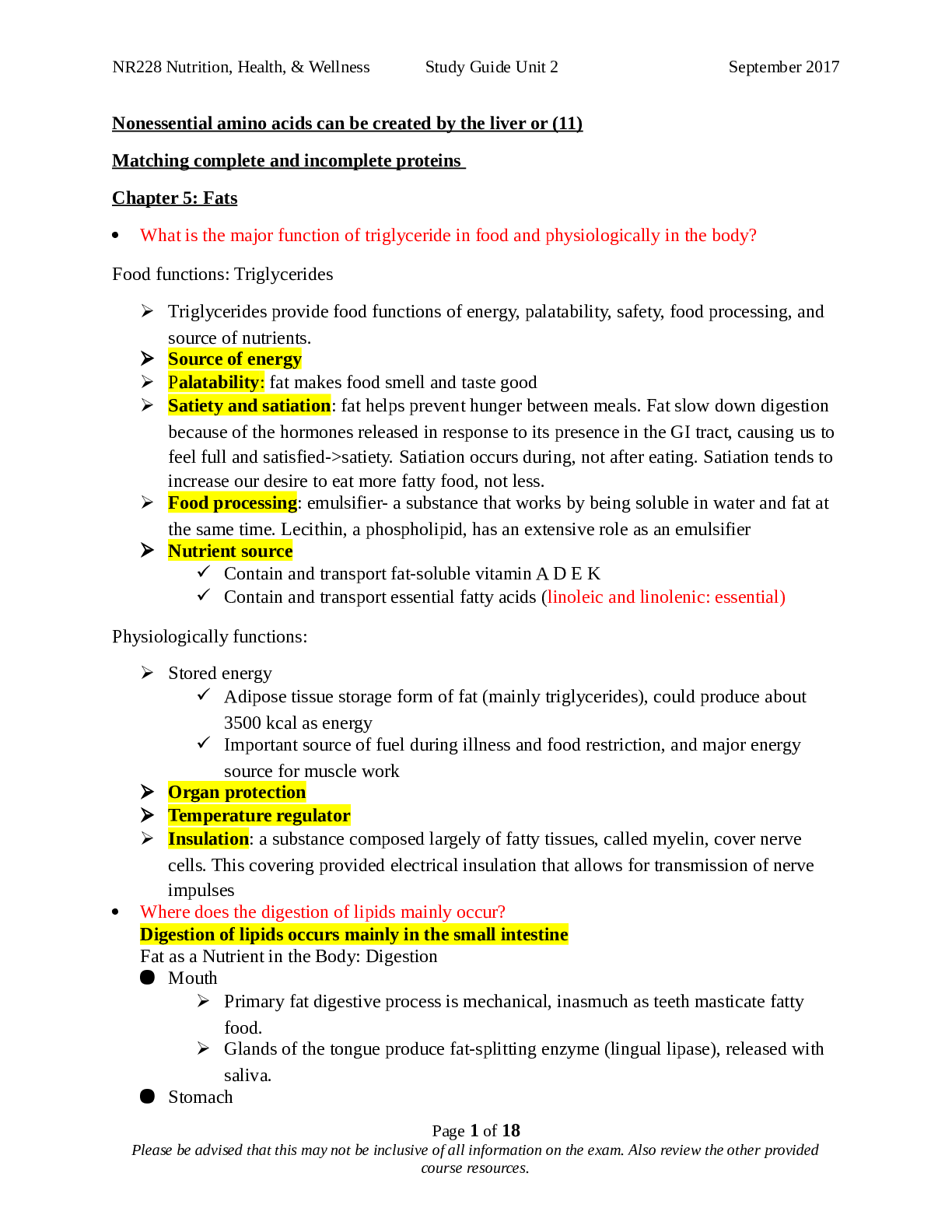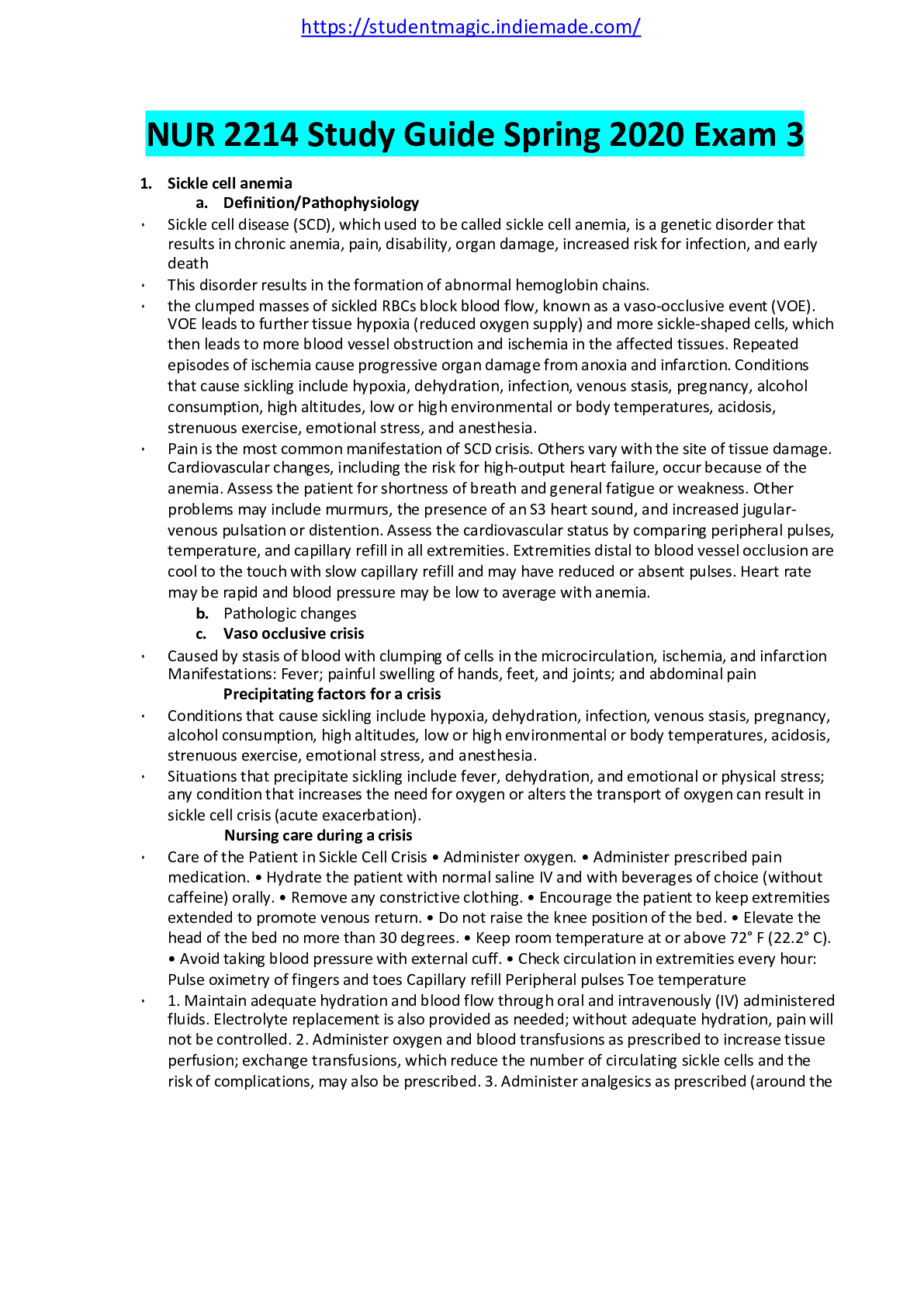*NURSING > STUDY GUIDE > NUR2474 Test # 2 Review/ Pharm Test 2 Review (All)
NUR2474 Test # 2 Review/ Pharm Test 2 Review
Document Content and Description Below
Topics to review: 1. Educating patients on how to use metered dose inhalers (wait 1 min between puffs, etc.). a. For any patient prescribed an inhaler, the RN should ensure the client can self admin... ister the medication. i. Teach back needed b. The patient should wait 1-2 minutes between puffs c. The patient should wait 5 minutes between 2 different inhalers d. The patient should take a bronchodilator before a corticosteroid medication (B before C) e. The patient must keep track of doses on their inhaler f. If opening a new inhaler, the patient should shake it and test before use. g. If dexterity is limited, a spacer can be used to get more medication in the airway. h. If the patient uses a steroid, they must wash their mouth out after use. i. If not, fungal infection may occur i. The patient should hold breath 10 seconds after receiving a puff. 2. Know the difference between short and long term treatments for asthma and COPD a. Short term asthma treatment: i. Bronchodilator: albuterol 1. Acts as a rescue inhaler during asthma attacks. 2. Onset is in 5 minutes and will last longer. ii. Xanthine Derivatives: theophylline 1. Dilates airways 2. Can have high drug interactions in the body iii. IV/ inhaled glucocorticoids.b. Long term asthma treatment: i. Bronchodilator: salmeterol. 1. Used to control symptoms of asthma 2. Never is used alone (often with steroid) ii. Anticholinergics: ipratropium bromide 1. For long term asthma prevention 2. Works very slowly. 3. Fast onset, short duration * Tiotropium has longer duration that Ipratropium iii. Corticosteroids: fluticasone or Budesonide 1. Non bronchodilation 2. Can take several weeks to show c. COPD treatment: i. Bronchodilator- short acting albuterol ii. Steroid iii. Must keep o2 saturation between 88-92% 1. Know classifications for respiratory drugs (what’s used as a rescue inhaler, and what is for long term management) a. Rescue inhalers: albuterol, epinephrine, metaproterenol, IV steroid b. Long term: salmeterol, ipratropium, theophylline, montelukast ,fluticasone 2. Treatment of acute asthma a. Oxygen use b. Short acting bronchodilator- albuterol c. Corticosteroid- ipratropium bromide IV d. Will relieve hypoxemia, reduce airway inflammation, and relieve obstruction. 3. Administration of bronchodilator (MOA,SE,Considerations) a. MOA: mimics the sympathetic NS and opens up the lungs and stimulates beta receptors b. Fast acting: used for acute asthma relief, Long acting is for chronic asthma management and COPD c. AE: tachycardia, angina, tremors, nervous and shaky feeling, hyperglycemia. d. Considerations: ensure patient takes medication as prescribed and does not overuse short acting bronchodilator. Never use it alone with asthma treatment. 4. Administration of glucocorticoids (IV vs inhaled, nursing interventions, pt. education) a. MOA: works to stop the inflammatory process in the lungs, preventing bronchoconstriction. Stabilizes WBC membranes that release bronchial constricting substances, increases bronchial smooth muscle beta adrenergic stimulation. b. Inhaled: used for asthma and is the most tolerated and fast acting, but can also be IV for systemic effects on the body. c. AE: throat and mouth irritation, dry mouth, oral fungal infections. d. Must be used with another drug for asthma control. e. Nursing interventions: must teach patients to rinse mouth out after steroid use to prevent oral fungal infections, take bronchodilator 5 mins before steroid. 5. Tiotropium administration, onset, and therapeutic level timeframesa. It is an anticholinergic medication used to treat maintenance therapy and bronchospasm in patients with COPD. Will block muscarinic receptors in lungs b. Inhaled form. c. Not for asthma d. Therapeutic effects start 30 min post inhalation, peaks in 3 hrs, and lasts 24 hrs. With consistent dosing, bronchodilation will improve after 8 days. e. AE: dry mouth. Can minimize by drinking fluids or sucking on hard candy. 6. OTC sympathomimetics (e.g., decongestants) use in cardiac patients a. Sympathomimetics stimulate the immune system. b. OTC decongestants such as pseudoephedrine are sympathomimetics. c. Patients with cardiac problems must have caution with use of these drugs and hypertension treatment. 7. Treatment principles of cold symptoms in children (treat individual symptoms) a. Many medications used OTC to treat colds are combination medications. b. In children, it can be dangerous if used as a combination medication for a cold. c. The parent should treat the symptoms only with individual agents and only with agents indicated for pediatric use. 8. Ulcer prevention with chronic NSAID use (identify specific med class) a. NSAIDs inhibit prostaglandin biosynthesis and reduce blood flow, mucus and bicarb. b. They increase risk of ulcers forming. c. Best treatment of NSAID ulcers is with H2 receptor blockers and PPI. d. Must also stop NSAID use as well. 9. Antacids and Cimetidine (patient education) a. Antacids are used to help neutralize acid secretions and promote gastric mucosal defenses in many ways and reduce pain associated with acid related disorders. i. Many different types such as Magnesium Salts, calcium carbonate, sodium bicarbonate, simethicone, etc. ii. AE: 1. Al/Ca= constipation 2. Mg= diarrhea 3. HCO3= metabolic alkalosis 4. Cal carbonate= increased acidity and renal calculi. b. Antacids also reduce the ability for other drugs to be absorbed into the body. c. Cimetidine is a H2 receptor blocker that works to block H2 receptors, reduce H ion secretion in parietal cells, suppress acid secretion and increase stomach pH i. AE: CNS confusion and depression in older adults, decreased libido, impotence and gynecomastia. ii. IV bolus= hypotension and dysrhythmias d. Antacids will reduce absorption of cimetidine. i. The patient must wait 1 hr before taking cimetidine and antacids e. Call HCP before buying OTC medications 10. General GERD treatment principles a. GERD there is a problem with the lower esophageal sphincter, allowing for acid to go up into the esophagus from the stomach.b. Will use PPI if anything to help. c. Once patient stops PPI, they can relapse and have GERD symptoms d. Relapse of GERD is often why medications are taken for long term maintenance. However, short term use may occur also. 11. PPI’s Omeprazole MOA, SE, Indications, use in older adults a. Proton Pump Inhibitors such as omeprazole and pantoprazole, help to prevent movement of hydrogen ions from cells into the stomach. causes all gastric acid secretions to be blocked (no HCl is produced!) b. Helps to treat GERD, esophagitis, short term gastric and duodenal ulcers, NSAID ulcers, stress ulcers, H. pylori formed ulcers. c. AE: HA, GI effects- D,N,V, pneumonia, osteoporosis, fractures, hypomagnesemia, c.diff, gastric cancer. d. Can be administered various ways: PO,IV, NG e. Use in older adults: encourage older adults to consume adequate calcium and vitamin D, as therapy can increase risk for fractures and osteoporosis. 12. Sucralfate (mechanism of action, interactions) a. Sucralfate is a cytoprotective drug that is used to treat stress ulcers and PUD. b. It works by attaching and binding to the base of ulcers, forming a proactive barrier over the area. It can then protect areas from pepsin that can break down proteins and make ulcers worse. c. AE: constipation, nausea, dry mouth. d. Can impair absorption of other drugs- must give other drugs 2 hrs before this one. Antacids may interfere with effects. e. Will bind with phosphate and reduce levels in renal patients. 13. General principles of treating constipation a. Constipation occurs when the patient has hard stools, infrequent stools, excessive straining, and unsuccessful defecation. b. Key thing is to assess patients to determine if it is real constipation, ileus or a bowel obstruction BEFORE giving medications. i. No laxative if Small Bowel Obstruction, ileus- do x ray, bowel sounds, etc. c. A cause of constipation is poor diet that is deficient in fiber and fluids. can be corrected this way. d. If diet does not help, laxatives may be used to soften the stool. i. They can reduce painful bowel elimination. ii. Decrease strain to prevent vasovagal stimulation. iii. Empty the bowel before treatment procedures iv. Obtain a fresh stool sample. v. Assist with loss of bowel tones. 14. Bulk forming laxatives administration principles a. Bulk forming laxatives work by absorbing water to increase bulk and soften stool. It also causes bowel distention to initiate reflex bowel activity. b. Administration: the patient must take a bulk forming laxative with a full cup (240ml) of juice or water. 15. Opiate use related constipation and treatmenta. Opiates work to decrease bowel motility and reduce pain by relief of muscle spasms. They also decrease transit time of stool through the bowel, allowing more time for water and electrolytes to be absorbed. b. Used for patients with frequent diarrhea, to decrease stool in ileostomy and decrease diarrhea from opioid withdrawal. c. If a patient takes too much of an opiate due to its dependent effects, a patient may experience s/s similar to morphine and may cause an increased constipation. The patient will need naloxone to help reverse this cause. 16. Senna side effects a. Senna is a stimulant of the intestines and works to increase peristalsis via intestinal nerve stimulation. b. A big side effect of Senna use is that the patient may have a yellow/brown or pink color to the urine that is harmless. 17. Stool softeners and surgical patients [Show More]
Last updated: 1 year ago
Preview 1 out of 12 pages
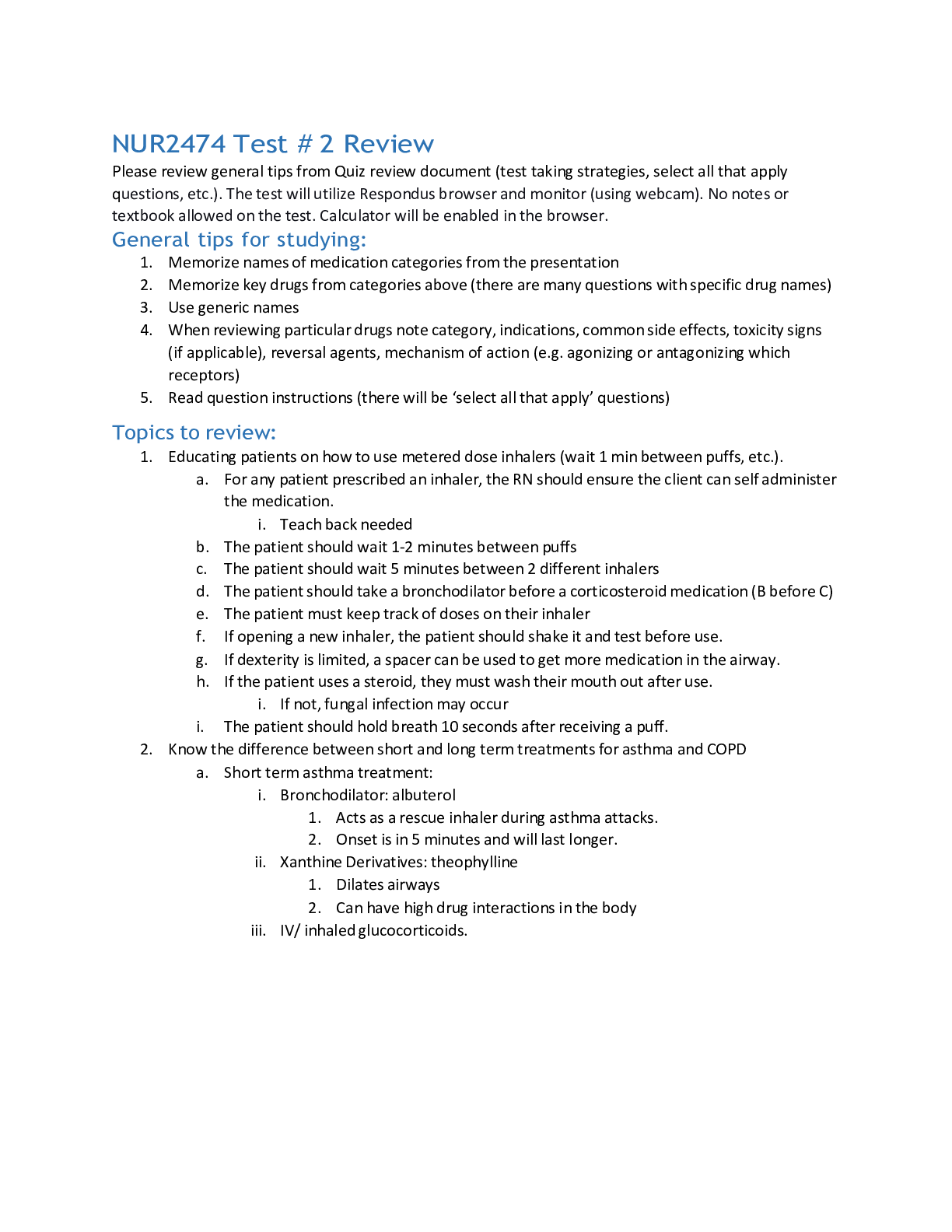
Reviews( 0 )
Document information
Connected school, study & course
About the document
Uploaded On
Aug 03, 2022
Number of pages
12
Written in
Additional information
This document has been written for:
Uploaded
Aug 03, 2022
Downloads
0
Views
77

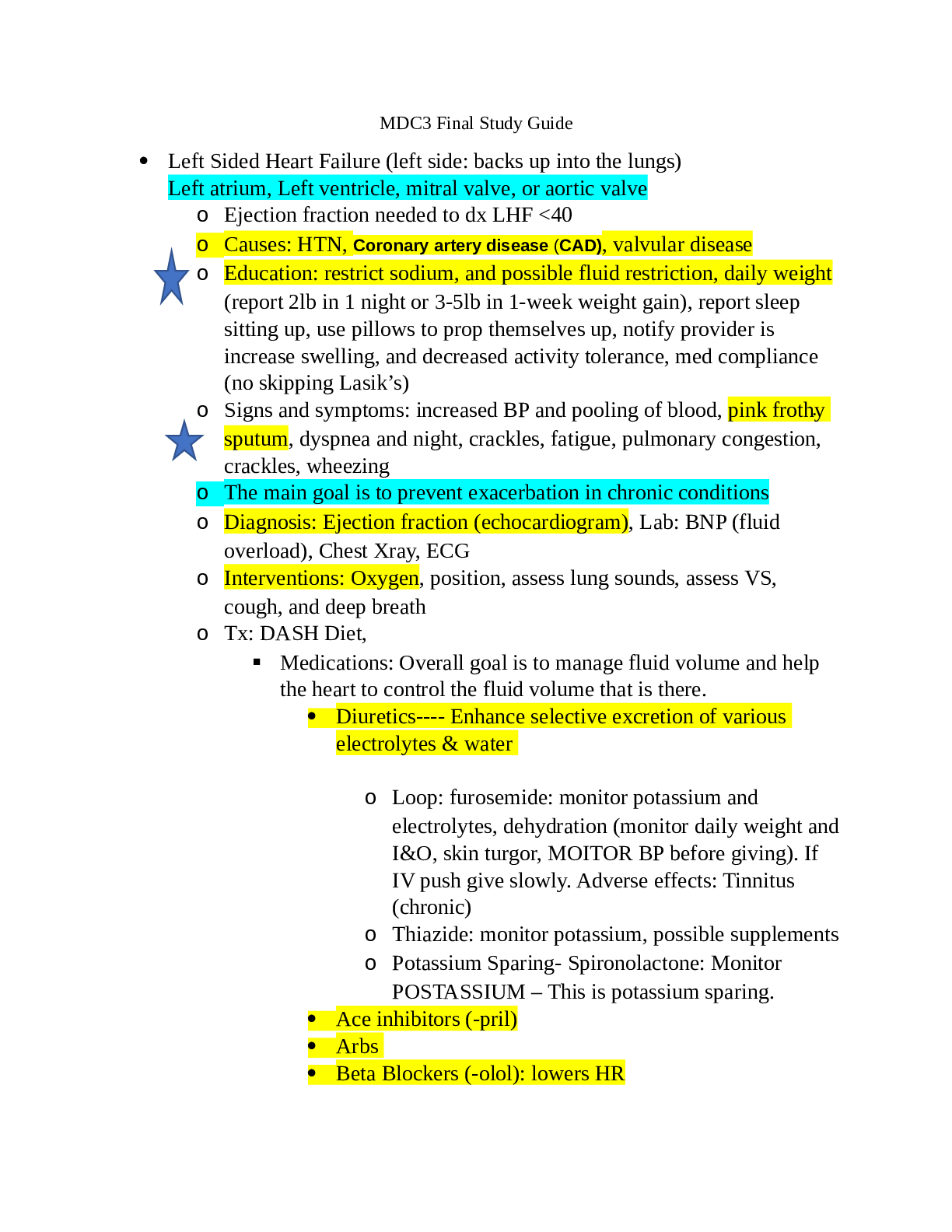
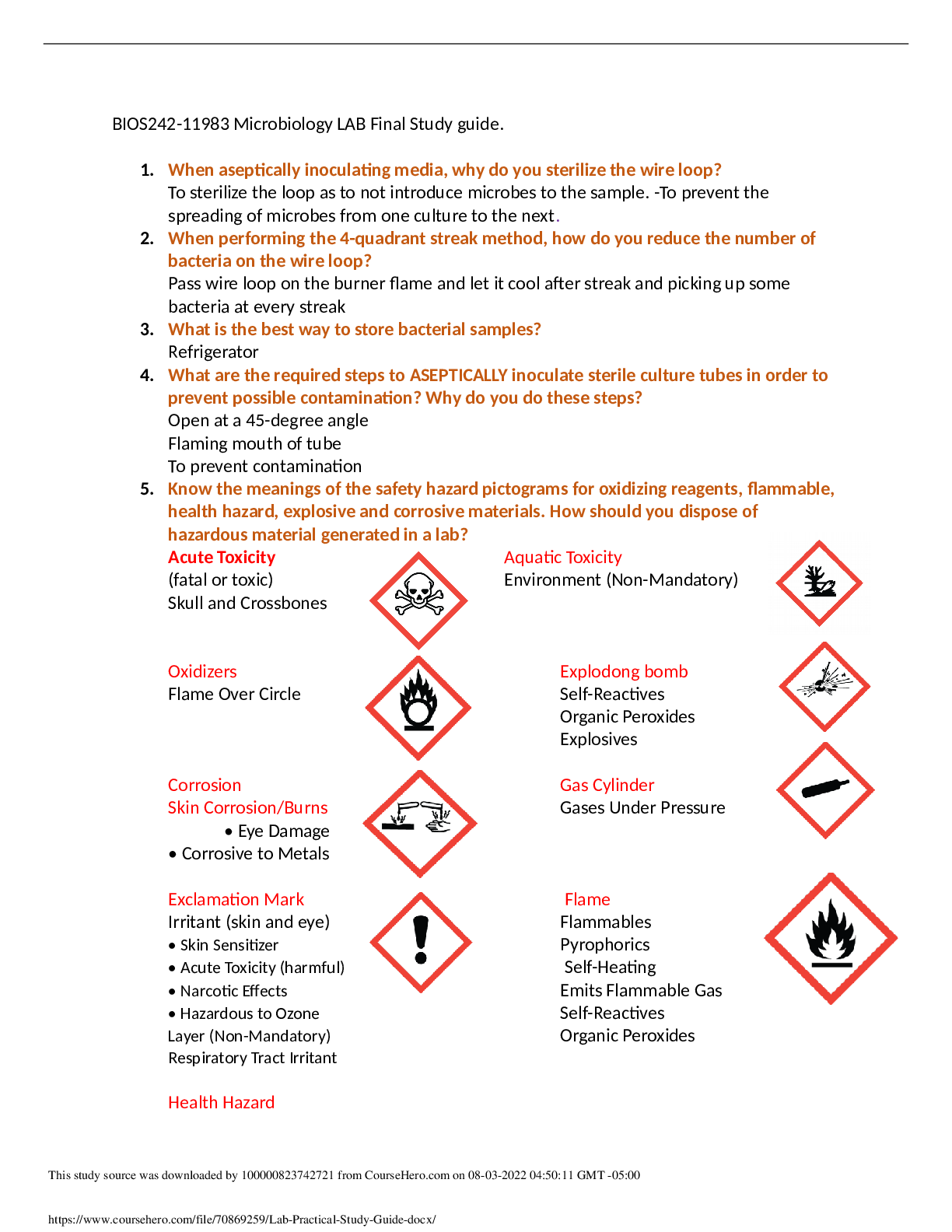
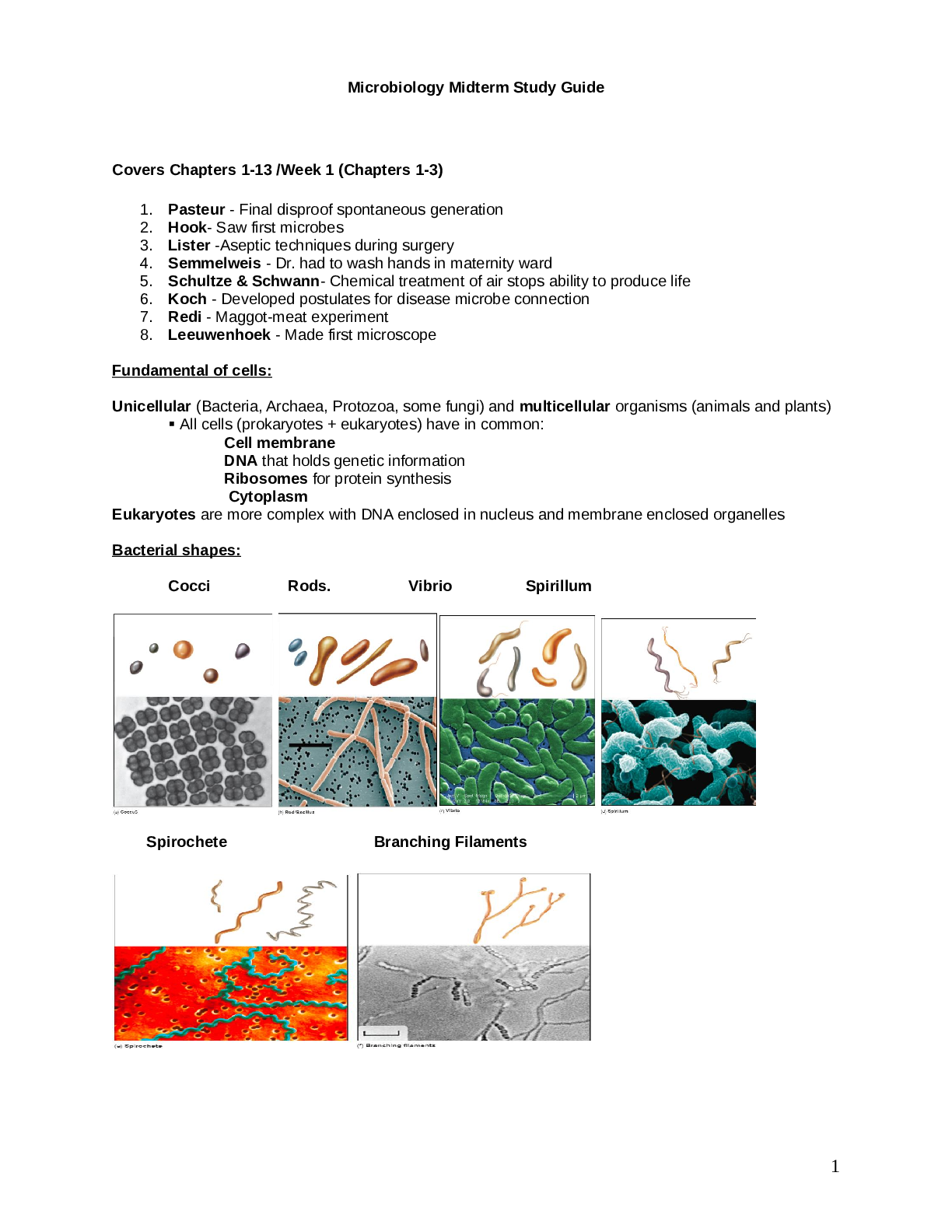

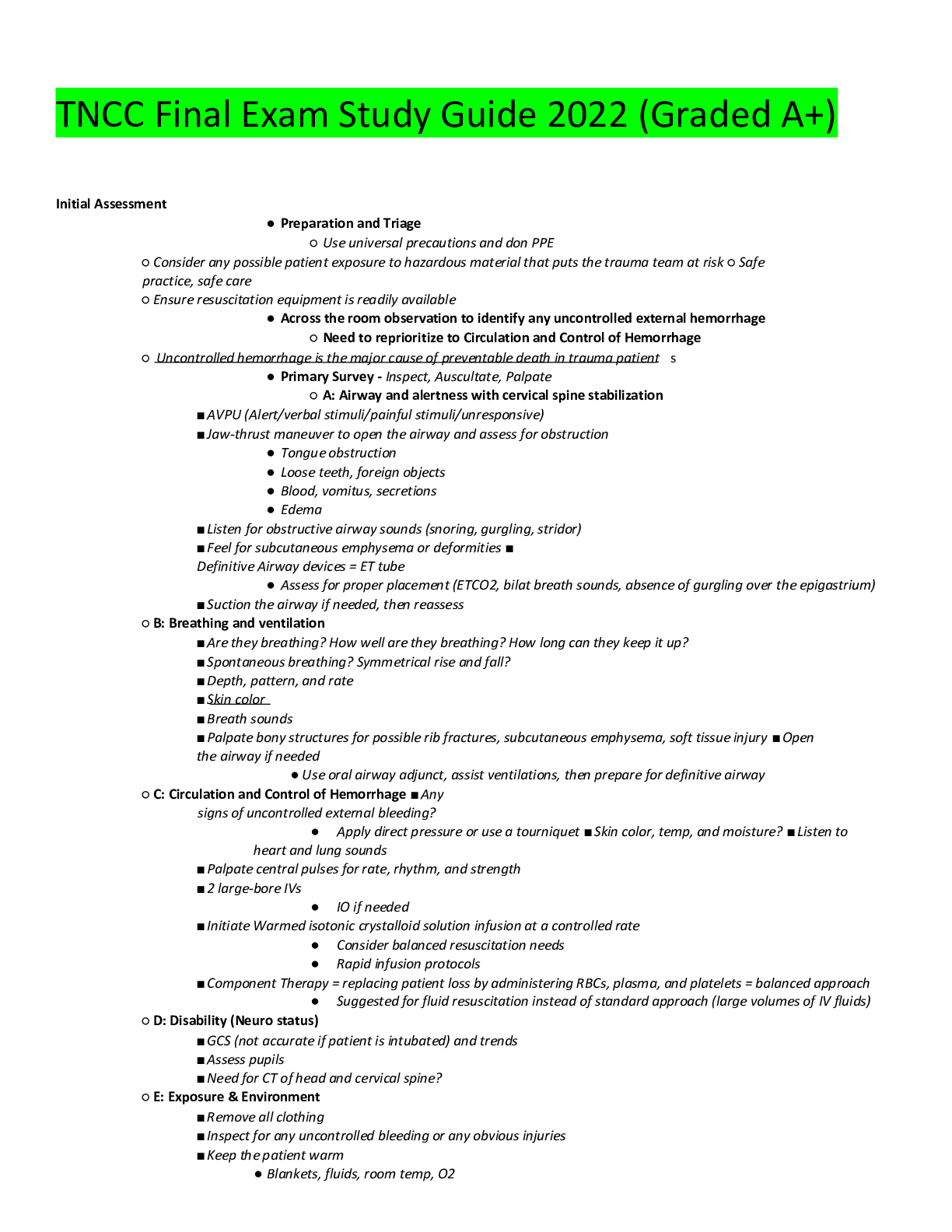
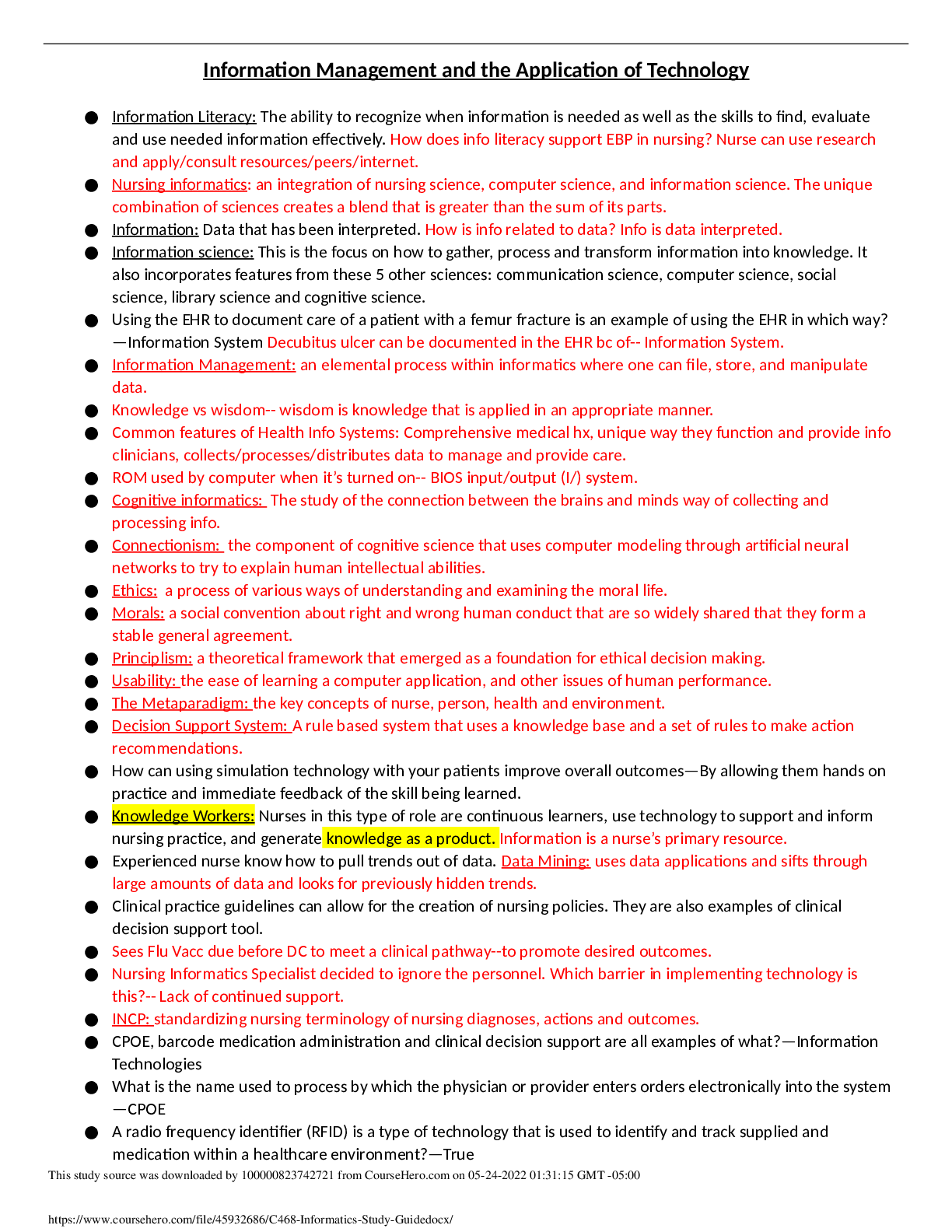

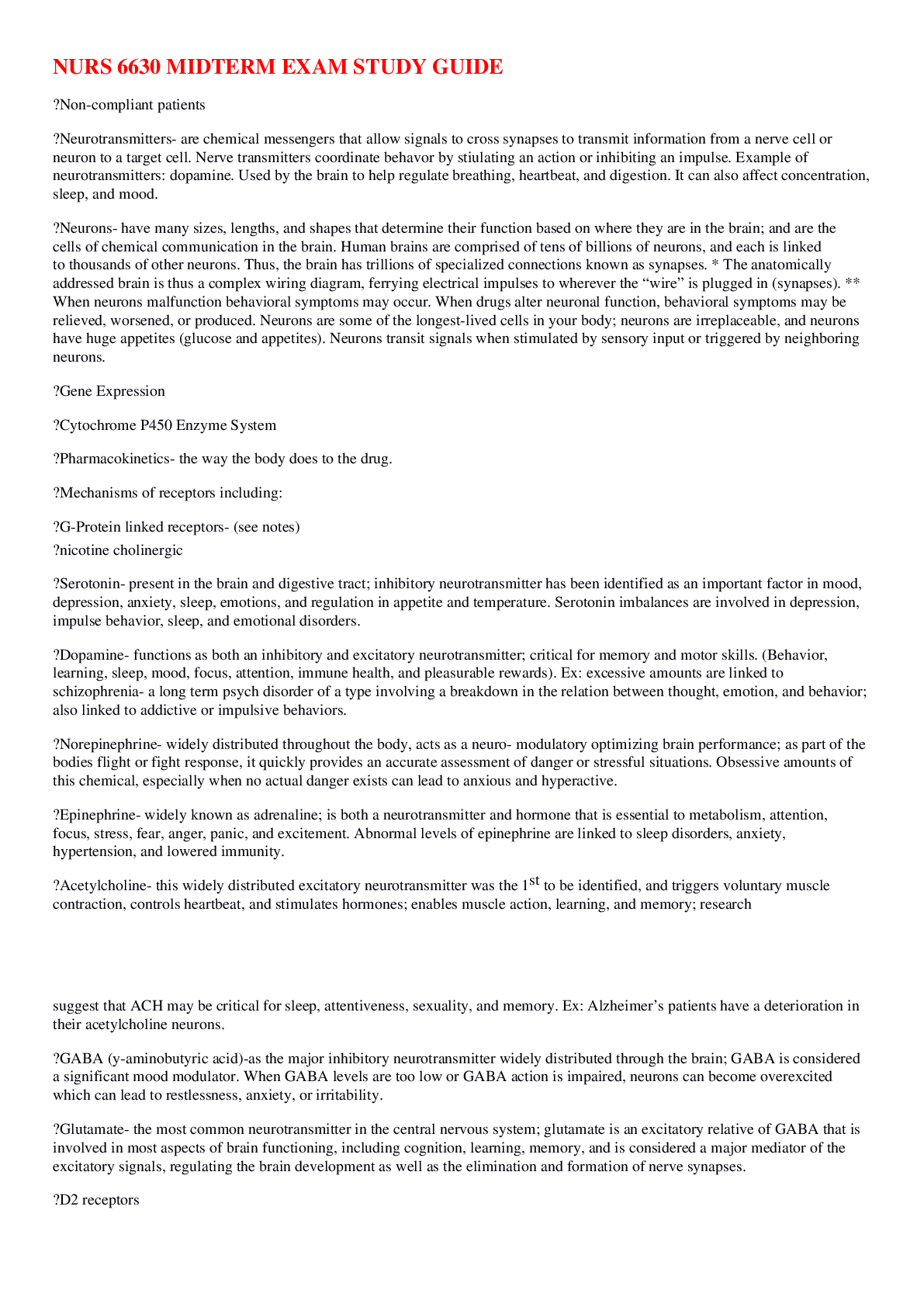
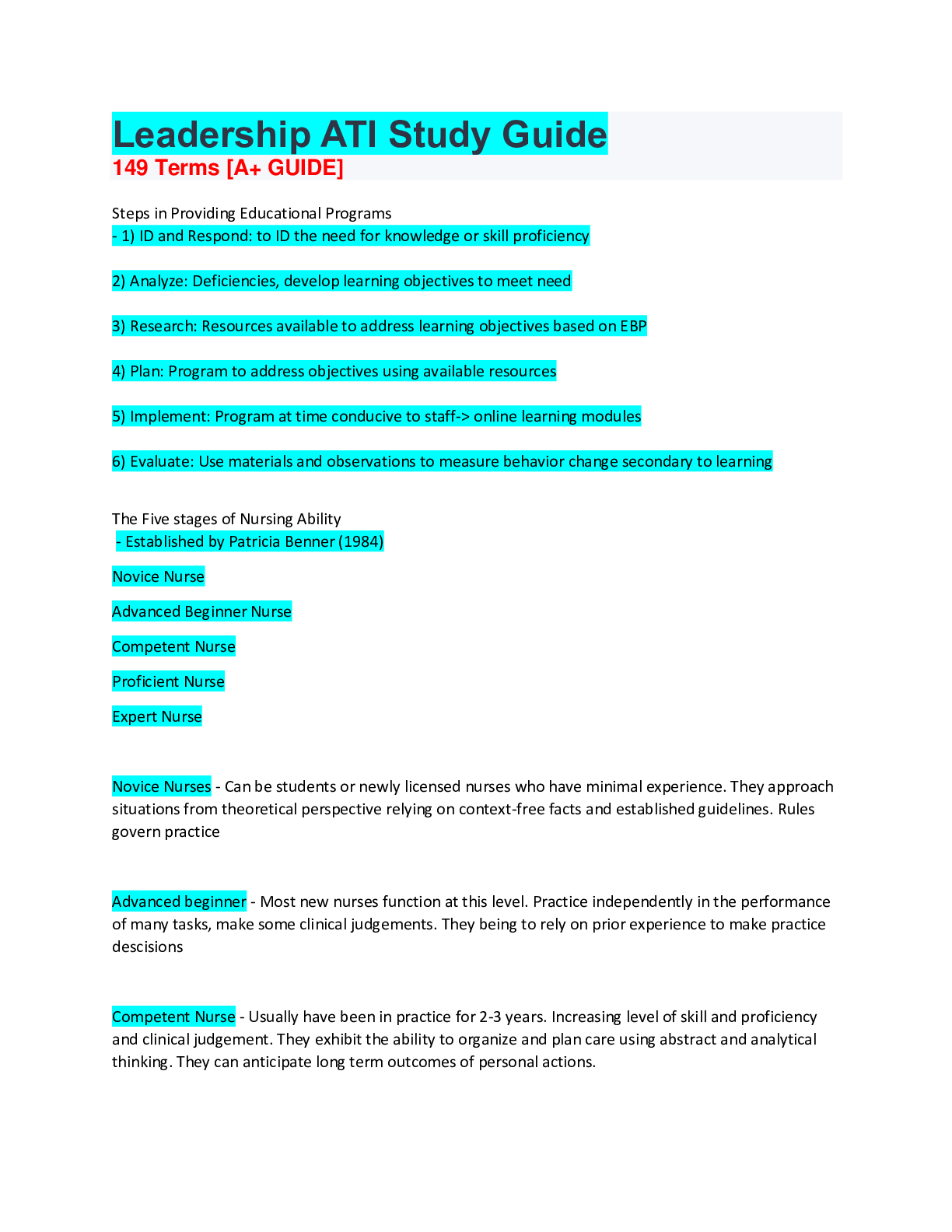
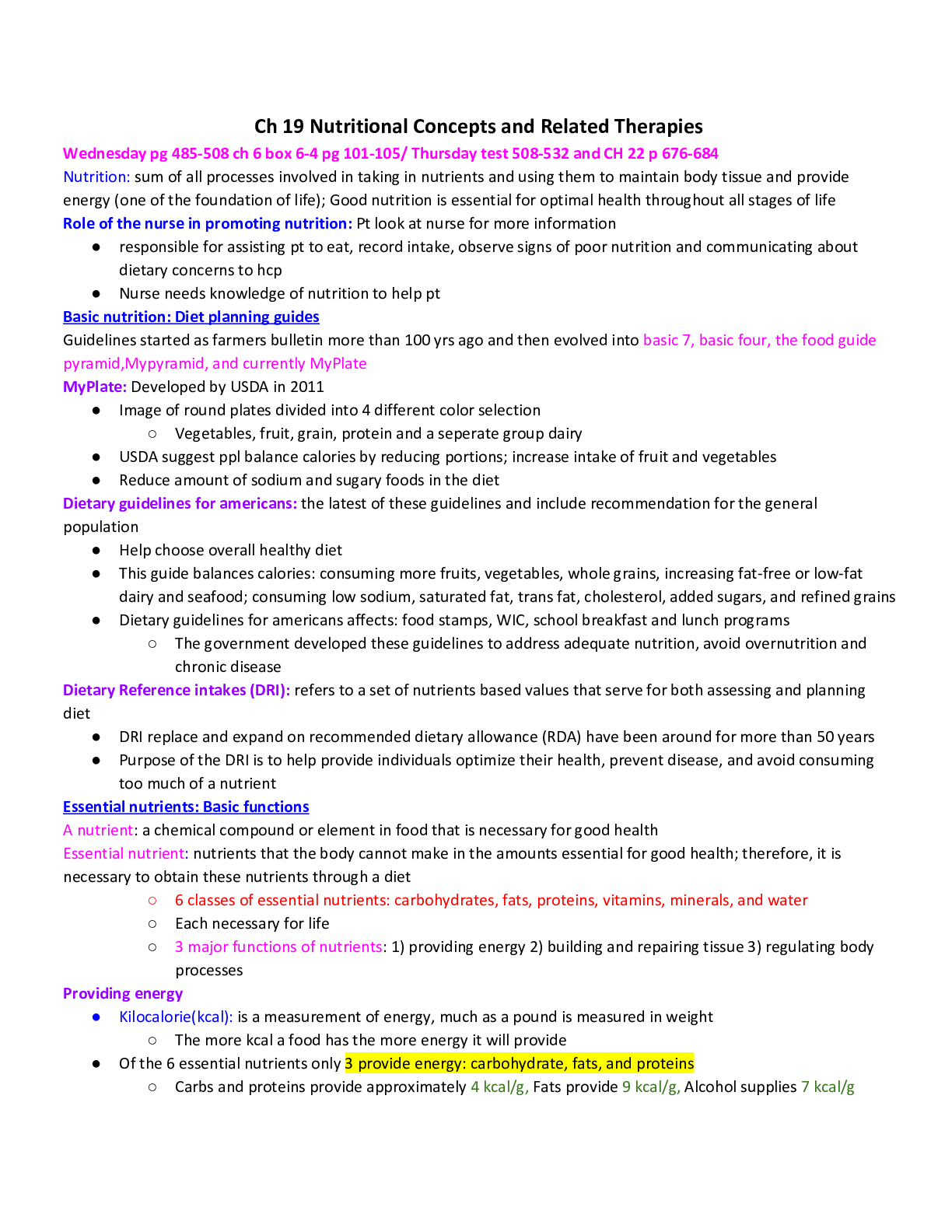
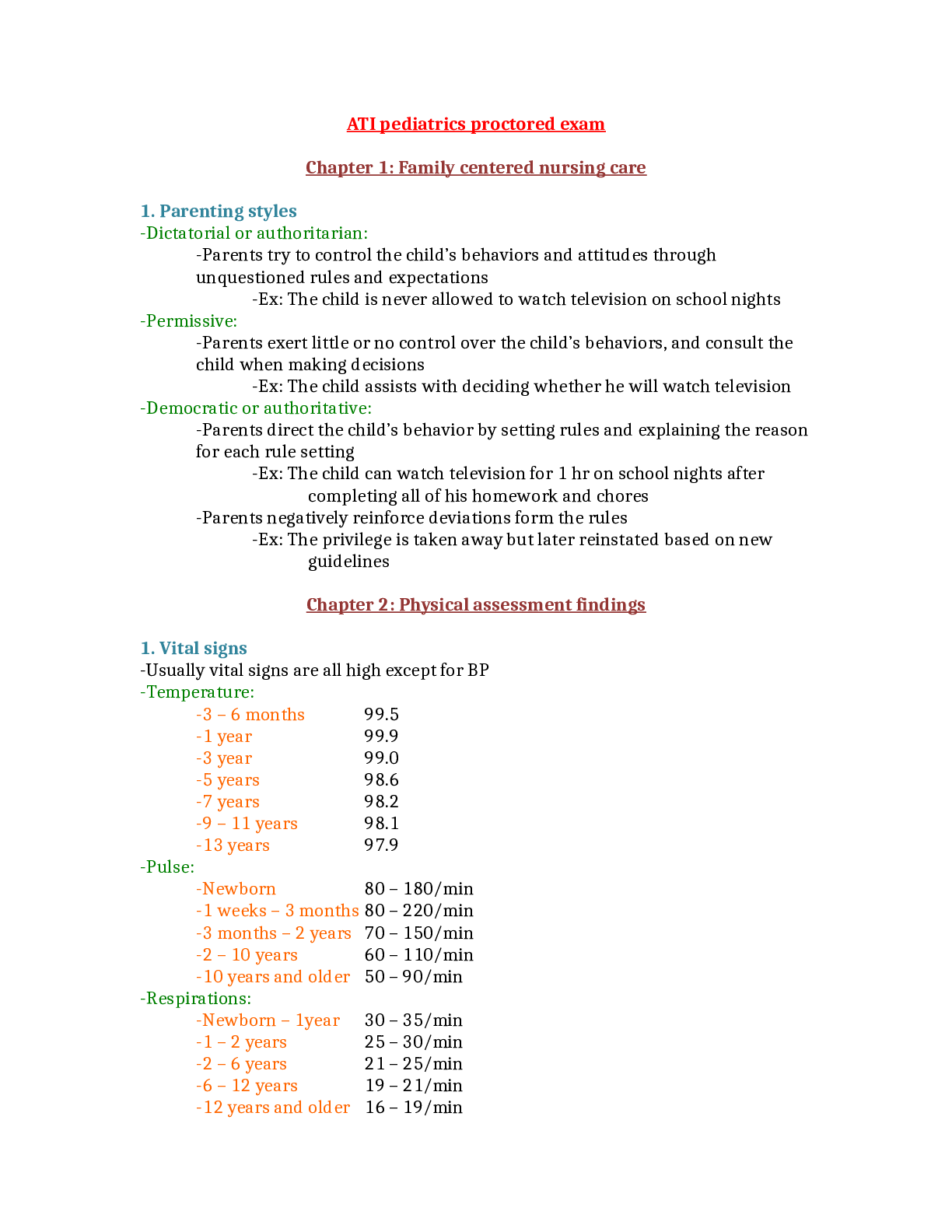


 e.png)






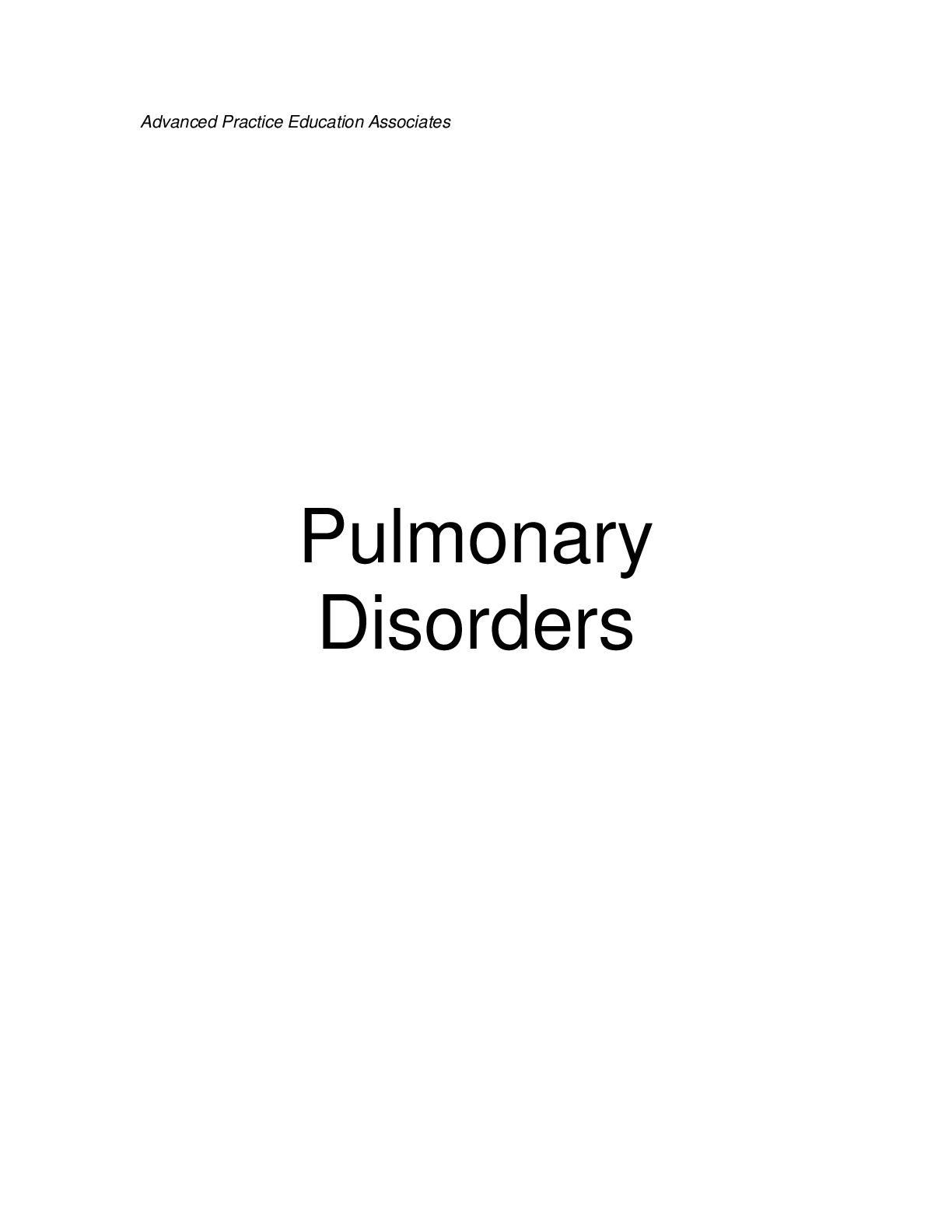
.png)





